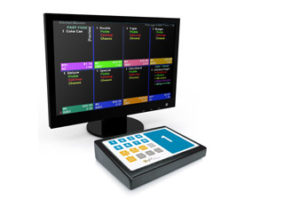ROI Analysis: Kitchen printers or kitchen video display?

Originally designed to handle fast food orders, kitchen video display systems have become increasingly common fixtures in fast food, casual and fine dining kitchens. Kitchen Display Systems eliminate steps, cut down on errors, improve productivity and speed of service, and drive increased guest satisfaction across all types and sizes of restaurants. Full color displays and multiple screen layouts make orders easy to read. The Bump Box is designed to make orders easy to control. And rich reporting keeps you on top of staff productivity at all times. With a Kitchen Display System, service is faster and more accurate, reports more detailed and complete, and end-of-day closings simplified: all at a significantly lower cost than printer, paper and ink.
The IT Perspective
Installation and configuration is typically very simple as everything is preconfigured, no matter how many controllers you run. Every network address, device ID, wireless connection—all the technical settings—are preset, or are configured automatically on initial startup: including integration with Maitre’D. You can modify any or all of these settings—from changing the IP address of the network adapter to changing the color displayed for soft drinks—from the most familiar of interfaces.
The Financial Perspective
Kitchen Display Systems have a lower Total Cost of Ownership (TCO) than Kitchen Printers.
For example,Maitre’D’s CVM, there are two cost elements; both one-time, fixed costs.
1. A perpetual license.
2. Flat screen monitor(s).
With printers, there are three costs: two of them go on forever.
1. The cost of the printer.
2. Annual cost of paper: $1,000
3. Annual cost of ribbons: $100
After four years, the cost of printing can be more than triple the cost of a kitchen display system.
Operations’ Point of View
A busy kitchen can struggle to maintain control in an environment driven by slips of paper. With a kitchen display system, the operational inefficiencies of the “enter-print-post” method of placing orders, fighting for a spin of the order wheels, expediting, and quality control are eliminated. The endless stream of orders coming out of paper printers— and the problems of backlog when paper runs out unnoticed—is ended.
In its place: a simple, direct connection from the point of sale to the place of preparation. It makes the last steps easier and more correct, providing both chefs and expeditors with pictures of the complete meal for garnishing and presentation control.
